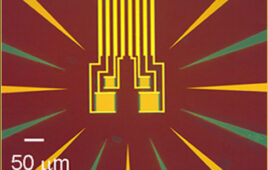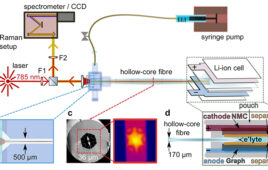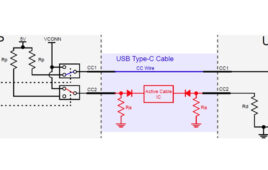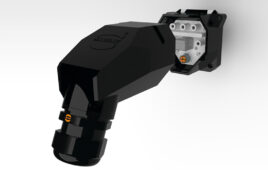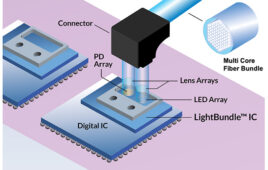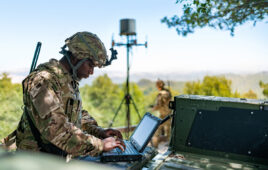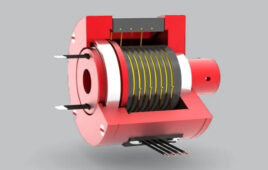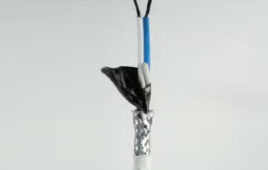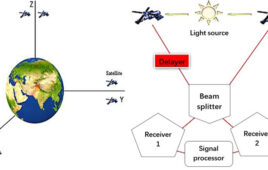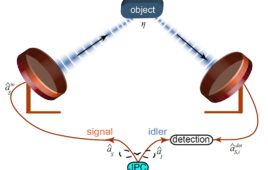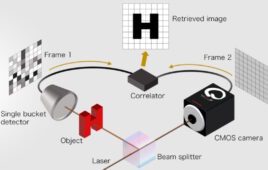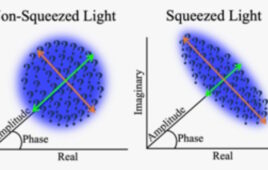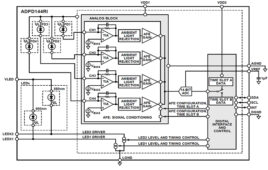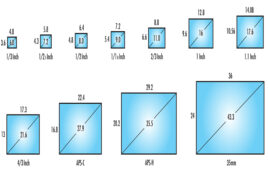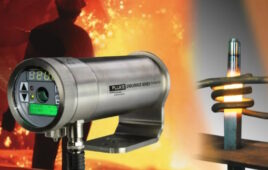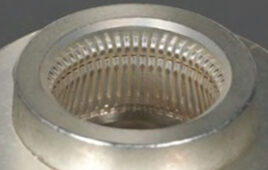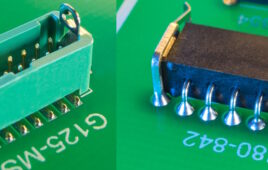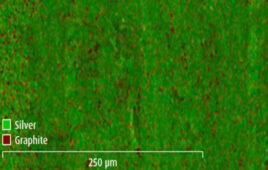A transition edge sensor (TES) is a microcalorimeter based on superconductivity. Compared with alternative technologies like energy dispersive X-ray spectroscopy (EDS), a TES can provide higher resolution measurements and resolve emission lines at closely adjacent energies. In astrophysics, TES is used to measure the relative abundance of elements like boron, carbon, and oxygen versus silicon […]
What are the applications for hollow core fiber optical sensors?
Hollow core fiber (HCF) optical sensors are used in applications including Li-ion battery research and development (R&D), robotic arms, civil engineering infrastructural health monitoring, and biosensing. Some of the attributes of HCF optical sensors are small footprints, non-conductance, chemical stability, and high dynamic ranges. In the case of activities like Li-ion R&D, HCFs can be […]
How are zinc oxide (sunscreen) WBG nanomaterials used in sensors?
Zinc oxide (ZnO) is a common ingredient in sunscreen lotions. Less well-known is the fact that it’s also a wide band gap (WBG) semiconductor (3.4 eV). As a nanomaterial, ZnO is being used to develop a wide variety of sensor technologies. Sensor applications for ZnO include health monitoring, chemical sensing, biomedical, and environmental sensors. Some […]
What is hyperspectral imaging?
Hyperspectral imaging is the most comprehensive of the three common image processing technologies. The other two technologies are red-green-blue (RGB) imaging and multispectral imaging. All three are noninvasive and nondestructive and give engineers and scientists different ways to analyze objects. RGB imaging can be quick and inexpensive to implement and provides basic information about an […]
USB proliferation of capabilities and compatibilities
USB4 represents a significant change from past standards from the USB Implementers Forum (USB-IF). It is based on the Thunderbolt 3 protocol. Support of Thunderbolt 3 interoperability is required on all ports for USB4 docks, for downward-facing ports on hubs, and is optional for USB4 hosts and peripheral devices. Like Thunderbolt, USB4 allows tunneling of […]
How does OPC UA PubSub data support connector digital twins?
The use of digital twins can be an important factor in maximizing the performance and flexibility of Industry 4.0 factories. Open Platform Communications (OPC) is the interoperability standard for the secure and reliable exchange of data in industrial automation environments. OPC has been expanded to include the unified architecture (UA), standardized as IEC 62541, that […]
How do connectors made with conductive plastics contribute to sustainability?
Basic plastics are electrically insulating, but with the proper additives, they can become conductive. Electrically conductive plastics can be used to replace metal components and improve sustainability in several areas of connector construction. They take less energy to fabricate and are lighter, reducing system weight, a very important consideration in applications like electric vehicles (EVs). […]
How does UCIe on chiplets enable optical interconnects in data centers?
Chiplets enable heterogeneous integration of various process nodes and materials to maximize performance. UCIe is a new die-to-die interconnect standard for high-bandwidth, low-latency, power-efficient, and cost-effective connectivity between chiplets. UCIe is also the first specification to include an interface that is compatible with optical links. Large computing systems needed to support high-performance computing (HPC) applications […]
What are the key design and selection considerations for MIL-SPEC connectors?
MIL-SPEC connectors are designed to operate reliably in challenging conditions and extreme environments. First developed in the 1930s for the US Armed Forces, military standard connectors are now used across multiple industries, from energy and aerospace to maritime and automotive. This article discusses key MIL-SPEC connector design requirements and reviews crucial connector selection criteria. It […]
What is the best copper alloy for connectors in renewable energy and EV applications?
Copper is important in supporting renewable energy and electric vehicles (EVs). For example, there’s about 5.5 tons of copper used per megawatt (MW) of photovoltaic generation and there’s 183 pounds of copper in an EV, compared with only 48 pounds in an internal combustion engine (IEC) vehicle. Not all copper is the same; there’s a […]
How can carbon nanotubes improve interconnect performance?
Carbon nanotubes (CNTs) have been proposed for reducing fretting wear in connectors used in high-vibration environments like vehicles. They can also be used to make contacts with lower contact resistance and higher corrosion resistance compared with silver (Ag) plating, and they have been used to reduce the weight in some shielded cables by 25% or […]
What quantum sensors can be used as GPS replacements?
There’s a variety of quantum sensors available for use as a global positioning system (GPS) replacement including quantum compasses, atomic gyroscopes, and atom interferometers. Several options for a quantum GPS replacement, also called quantum position sensing (QPS), are being developed. Three examples include quantum active navigation that overlays and supplements existing satellite-based GPS systems, quantum […]
How does a quantum radar sensor work?
It generates quantum entanglement between a microwave resonator and a signal that is emitted toward a target and can theoretically make radar detection up to four times faster in scenarios with comparable signal power and target noise. It also reduces susceptibility to jamming. A microwave quantum radar begins with a stream of entangled visible-frequency photons […]
How can quantum sensors and quantum batteries improve electric vehicle operation?
In the near term, quantum sensors are being developed that can more accurately measure EV battery capacity, assess battery safety, and reduce vehicle weight. In the longer term, quantum batteries have been proposed that could dramatically improve the speed and efficiency of battery charging. The energy remaining in an EV battery has been estimated using […]
What are the seven types of quantum sensors?
The seven types of quantum sensors include chemical sensors, clocks, gravimeters, imaging, interferometers, magnetometers, and thermometers. Several types of quantum sensors are already in use, and more are being developed for commercialization. They can be used in a wide variety of applications from earth sciences to molecular biology and wide band gap power semiconductors. Chemical […]
What technologies are used to make quantum sensors?
Quantum sensors rely on quantum mechanical principles like entanglement, interference (also called superposition), discrete quantum states, and coherence. They are unlike quantum computers, which need highly stable environments for operation. Some quantum sensors can operate at room temperature. As a result, quantum computers are still a work in progress, while quantum sensors are used today. […]
How do micro photo sensors work and what are they used for?
Micro photo sensors have built-in amplifiers and are available in a variety of configurations, with modulated, non-modulated, and polarized light beams. They’re used to provide precise and stable sensing or positioning of materials, components, or assemblies. Some have integrated connectivity, like IO-Link and IP 67 environmental ratings. Uses for micro photo sensors include precision manufacturing […]
What are the key specifications of machine vision sensors?
Charged coupled devices (CCDs) and CMOS active pixel sensors (CMOS sensors) are the primary image sensor technologies. They rely on lenses and other optical components to deliver the image to be captured. This FAQ reviews the differences between CCDs and CMOS sensors, looks at some key specifications of image sensors and the concept of quantum […]
How many ways are there to measure temperature?
Temperature is the most commonly measured physical quantity. Thermometry, the measurement of temperature, involves a wide range of technologies. Its uses range from maintaining a comfortable and safe environment for people to industrial processes operating at over 3,000 °C and quantum computing operating at near absolute zero. This FAQ reviews some of the more common […]
What are ZIF and LIF connectors and where are they used?
How low contact resistance is achieved can be a key differentiator between zero insertion force (ZIF) and low insertion force (LIF) connectors. Many LIF connectors have a low contact resistance of about 30 mΩ when mated without needing a locking mechanism. ZIF connectors generally require a locking mechanism to achieve low contact resistance and a […]
How do the three types of shielded cables work?
The three basic types of shielding for electromagnetic interference (EMI) in cables include strands of braided copper and similar metals, spiral shields, and foil or tape shields. They can be used separately or in combination. This FAQ begins with a review of the three types of shielding, then considers how they are used in combinations […]
What are the six connector locking mechanisms?
Various locking mechanisms are found on connectors including bayonet, latch, lever, push-pull, screw, and snap-in. These represent the more common styles, not an exhaustive list. Locking connectors can support several functions like assisting coupling and uncoupling and improving the environmental ruggedness of the connection in addition to enhancing mechanical performance and preventing accidental uncoupling. This […]
What are the five connector contact termination styles used for?
The five basic connector contact termination styles include solder, press-fit, clamp, crimp, and insulation displacement (IDC). In some cases, there are variations. This FAQ focuses on the termination of electrical signals, not fiber optic termination styles. Selecting the best termination style is important since the terminations provide stable electrical and mechanical connections and need to […]
What is electric vehicle supply equipment (EVSE)?
EVSEs provide power to charge EV batteries at Level 1 and Level 2 voltage ratings. Electric vehicle (EV) owners rely on electric vehicle supply equipment (EVSE) to charge their batteries efficiently. Often referred to as charging stations or docks, EVSEs provide a reliable and safe connection between EVs, the electric grid, and other energy sources. […]
What plating options are available for high-power connectors?
Plating options are numerous and tend to fall into four categories: noble metals, passive metals, alloys, and dispersions. The first three categories are well established, while dispersions are just beginning to appear in response to the need for high-power connectivity in electric vehicle (EV) charging and similar applications. This FAQ starts with a brief review […]

